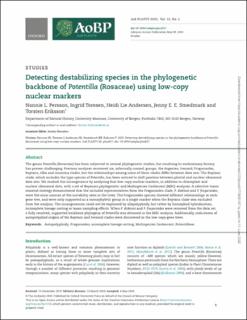| dc.description.abstract | The genus Potentilla (Rosaceae) has been subjected to several phylogenetic studies, but resolving its evolutionary history has proven challenging. Previous analyses recovered six, informally named, groups: the Argentea, Ivesioid, Fragarioides, Reptans, Alba and Anserina clades, but the relationships among some of these clades differ between data sets. The Reptans clade, which includes the type species of Potentilla, has been noticed to shift position between plastid and nuclear ribosomal data sets. We studied this incongruence by analysing four low-copy nuclear markers, in addition to chloroplast and nuclear ribosomal data, with a set of Bayesian phylogenetic and Multispecies Coalescent (MSC) analyses. A selective taxon removal strategy demonstrated that the included representatives from the Fragarioides clade, P. dickinsii and P. fragarioides, were the main sources of the instability seen in the trees. The Fragarioides species showed different relationships in each gene tree, and were only supported as a monophyletic group in a single marker when the Reptans clade was excluded from the analysis. The incongruences could not be explained by allopolyploidy, but rather by homoploid hybridization, incomplete lineage sorting or taxon sampling effects. When P. dickinsii and P. fragarioides were removed from the data set, a fully resolved, supported backbone phylogeny of Potentilla was obtained in the MSC analysis. Additionally, indications of autopolyploid origins of the Reptans and Ivesioid clades were discovered in the low-copy gene trees. | en_US |

